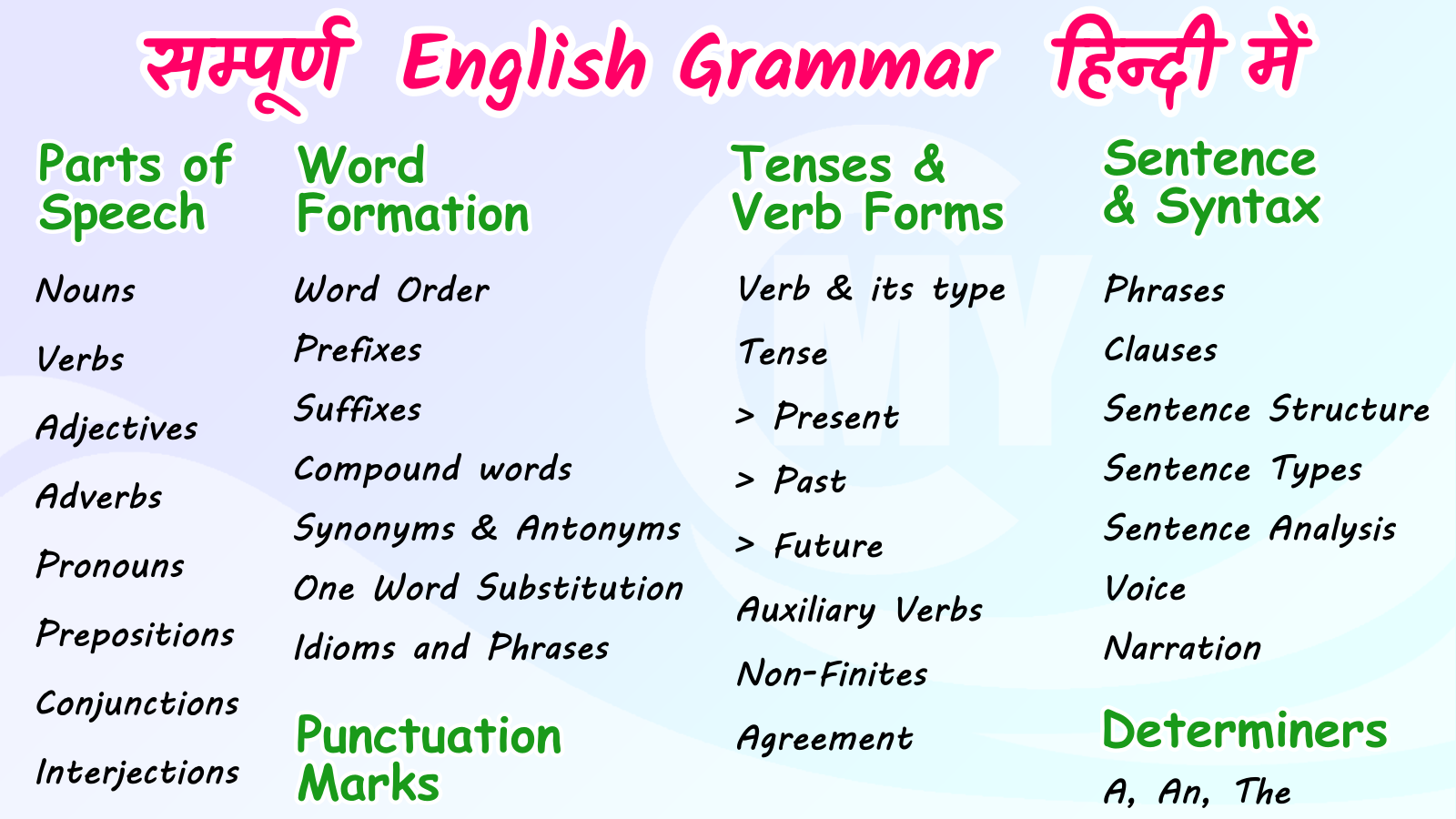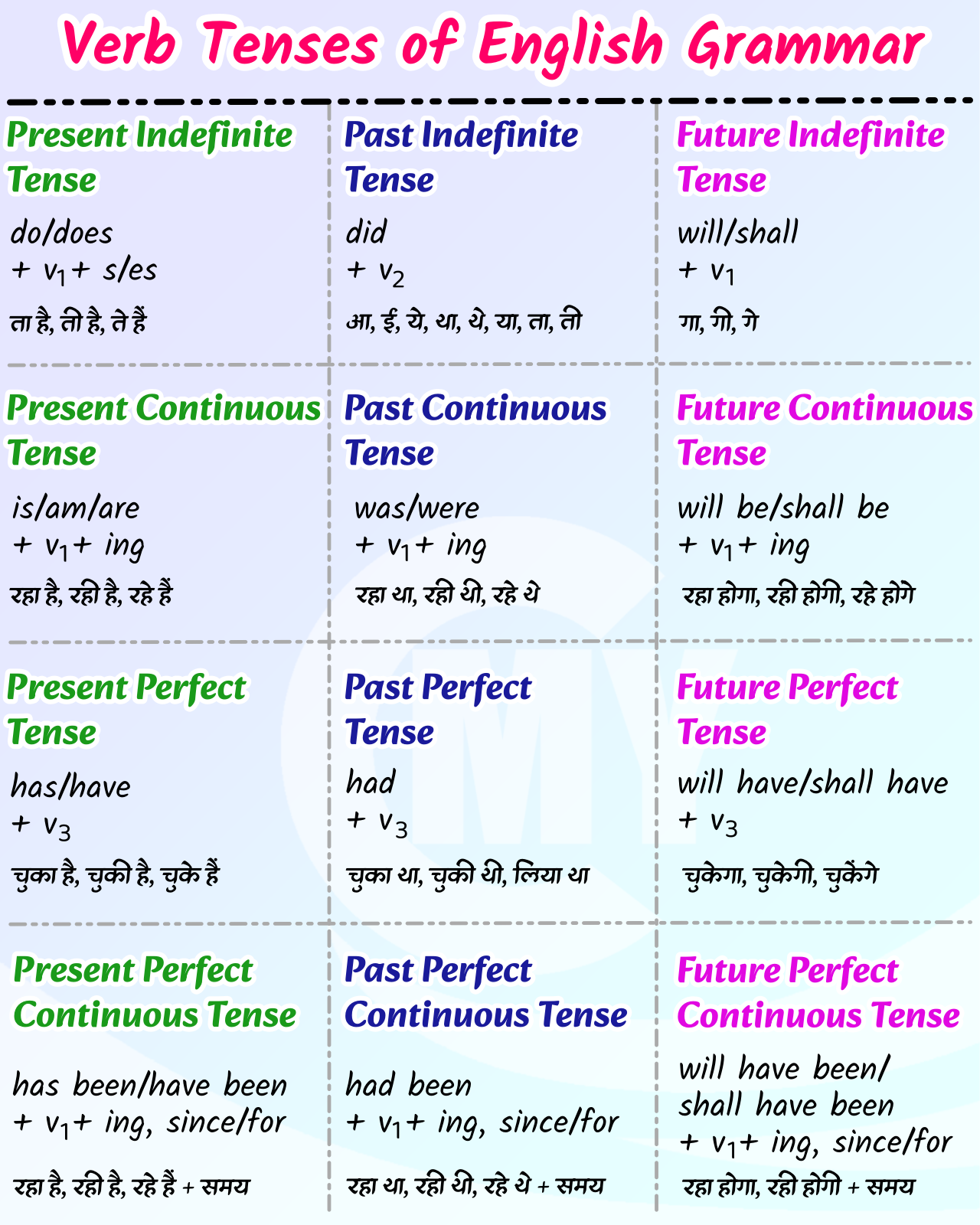
यदि आपने “English Grammar in Hindi” अभी-अभी सीखना शुरू किया है, तो आपको सबसे पहले Hindi Medium में अंग्रेजी व्याकरण सीखने के लिए हिंदी में भाषा के कुछ बुनियादी नियमों को जानना होगा। यहां हम बुनियादी स्तर से आपकी भाषा Hindi के अंदर English Grammar को स्टेप बाई स्टेप सीखेंगे।
English Grammar क्या है? (What is English Grammar?)
Grammar, किसी Language की Structure, Behavior, और Rules का अध्ययन करने वाला science है। यह किसी भाषा को उसके Letters, Words, Sentences और उनके rules का अध्ययन करके उसे समझने और व्याख्या करने का प्रयास करता है।
Grammar is the system of rules and principles that govern the structure, formation, and usage of a language. It encompasses the study of how words are formed, how they are combined into phrases and sentences, and how their arrangement affects meaning and interpretation.
English Grammar का मुख्य उद्देश्य भाषा की Structure और Usage के पीछे के Rules को Analyze करना है। इससे हमें भाषा के Correct और Easy Use में मदद मिलती है। इसमें विभिन्न Concept और Principles होते हैं, जिनका पालन करके हम Correct Sentence बना सकते हैं।
Grammar का अध्ययन आपको भाषा के Structural और Regulatory पहलुओं को समझने में मदद करता है, जिससे आप उच्चतर स्तर की भाषा का प्रयोग व्यवहार में ला सकें।
Hindi Medium English Grammar
Hindi Medium में English Grammar को सीखने के लिए के अंग्रेजी व्याकरण के सभी Chapters उनके Rules और Pdf Notes नीचे दिए जा रहे हैं-
Chapters of English Grammar in Hindi Medium:
- अंग्रेजी भाषा
- Letters: English Alphabets (वर्ण)
- Words (शब्द)
- Phrases (शब्द-समूह)
- Clauses (उपवाक्य)
- Parts of Speech (शब्द-भेद)
- Noun (संज्ञा)
- Pronoun (सर्वनाम)
- Adjectives (विशेषण)
- Comparative and Superlative Adjective
- Verbs (क्रिया)
- ‘Be’ Verbs
- Action Verbs
- Subject Verb Agreement
- Irregular Verbs
- Non-Finite Verbs
- Gerunds
- Infinitives
- Auxiliary Verbs – ‘Be,’ ‘Do,’ ‘Have’
- Auxiliary Verbs – ‘Will/Would,’ ‘Shall/Should’
- Auxiliary Verbs – ‘Can/Could,’ ‘May/Might/Must’
- Adverb (क्रिया विशेषण)
- Preposition (संबंधबोधक)
- ‘On,’ ‘At,’ ‘In’
- ‘Of,’ ‘To,’ ‘For’
- ‘With,’ ‘Over,’ ‘By’
- Conjunction (समुच्चयबोधक)
- Coordinating and Correlative Conjunctions
- Subordinating Conjunctions
- Conjunctive Adverbs
- Interjection (विस्मयादिबोधक)
- Determiners (निर्धारक, The, A, An)
- Articles: Indefinite Articles and Definite Articles
- Adjectives: Possessives, Numbers, Quantifiers, Demonstratives, Interrogatives
- Tense (काल)
- Present Tense
- Past Tense
- Future Tense
- Sentence (वाक्य)
- Simple Sentences (Simple Tense) (साधारण वाक्य)
- Complex Sentence (मिश्रित वाक्य)
- Compound Sentence (संयुक्त वाक्य)
- Moods in English grammar
- Imperative Mood
- Indicative Mood
- Subjunctive Mood
- Voice (वाच्य)
- Active Voice
- Passive Voice
- Narration
- Capitalization
- Vocabularies
- Synonyms
- Antonyms
- One Word Substitution
- Idioms and Phrases
Download: English Grammar Pdf in Hindi

Advanced English Grammar in Hindi
Advanced English Grammar उन Chapters का संग्रह है जो आपकी अंग्रेजी भाषा की समझ और व्याकरणिक ज्ञान को उच्च स्तर पर ले जाने के लिए तैयार किए गए हैं। उच्च स्तर की अंग्रेजी व्याकरण के चैप्टर निम्नलिखित हैं:
- Punctuation: Periods, Commas, Question Marks, Exclamation Marks, Quotation Marks
- Modal Verbs: Can, Could, May, Might, Shall, Should, Will, Would, Must
- Phrasal Verbs: Separable Phrasal Verbs, Inseparable Phrasal Verbs, Phrasal Verbs with Prepositions
- Conditionals: Zero Conditional, First Conditional, Second Conditional, Third Conditional
- Gerunds and Infinitives: Gerunds as Nouns, Infinitives with Verbs
- Reported Speech: Statements, Questions, Commands, Requests
- Direct and Indirect Speech: Reporting Verbs, Verb Tense Changes, Pronoun Changes
- Agreement: Subject-Verb Agreement, Pronoun-Antecedent Agreement, Adjective-Noun Agreement
- Question Tag
- Verb Advance
- Syntax
- Spelling Rules
- Close Passage/Close Test
- Sentence Improvement
- Word Formation: Prefixes, Suffixes, Compound Words
- Word Arrangement
- Construction of Sentence
- Word often Used and Misused
- Ordering of Sentence
Translation: अंग्रेजी व्याकरण में अनुवाद
अंग्रेजी व्याकरण के इस भाग में हिन्दी वाक्य/पैराग्राफ/कहानी को अंग्रेजी में अनुवाद करना सिखाया है। यह उन सभी के लिए उपयोगी होगा जो अंग्रेजी व्याकरण में ट्रांसलेशन सीखना चाहते हैं। विशेष रूप से, हिन्दी मीडियम के छात्रों के लिए रामबाण साबित होगा। अंग्रेजी व्याकरण में अनुवाद (Translation) के लिए उपयोगी चैप्टर निम्नलिखित हैं:
- Various Forms of the Verbs
- Use of ‘To Be’-Is, Am, Are, Was, Were
- Imperative Sentences
- Present Indefinite Tense (Simple Present)
- Present Continuous Tense (Present Imperfect or Present Progressive)
- Present Perfect Tense
- Present Perfect Continuous Tense
- Past Indefinite Tense (Simple Past)
- Past Continuous Tense
- Past Perfect Tense
- Past Perfect Continuous Tense
- Future Indefinite Tense (Simple Future)
- Future Continuous (Imperfect) Tense
- Future Perfect Tense
- Future Perfect Continuous Tense
- Use of ‘Have’, ‘Has’ and ‘Had’ (As Principle Verbs) d
- Habitual Actions
- Degrees of Comparison
- Use of Articles (A, An & The)
- Use of Prepositions
- Use of Apostrophe and Case in Apposition
- Use of Some Verbs
- Use of ‘How Many’, ‘How Much’, ‘There’, ‘It’, ‘Is Made of’ and ‘Is Made from’
- Exclamations and Wishes
- Active and Passive Voice
- Direct and Indirect Speech
- Non-Finites
- The Sequence of Tenses
- The Complex Sentences
- The Compound Sentences
- Passages for Translation into English
Composition (रचनात्मक लेखन)
यहाँ आपको Composition जैसे कि- Literature (साहित्य), Prose (गद्य), Poetry (कविता), और Class-wise निबंध (1st to 12th) के लिए guidance और resources मिलेंगे, साथ ही हिंदी में अंग्रेजी व्याकरण के स्पष्टीकरण भी दिए गए हैं।
- English Literature
- Prose
- Poetry
- Essay
- Class Wise Essay (1st to 12th & above)
- Primary Schools
- Junior Schools
- Pre-Metric Schools
- Metric Schools
- Post Metric Schools
- Application & Letters
अंग्रेजी व्याकरण के चैप्टरवाइज अभ्यास प्रश्न
- Verb Basic Practice Set
- Tense Practice Set
- Passive Voice Practice Set
- Narration Practice Set
- Subject Verb Agreement Practice Set
- Conditional Sentence Practice Set
- Verb Advance Practice Set
- Noun Practice Sets
- Pronoun Practice Set
- Adjective Practice Set
- Conjunction Practice Set
- Article Practice Set
- Preposition Practice Set
- Adverb Practice Set
- Synonyms Practice Set
- Antonyms Practice Set
- One Word Substitution Practice Set
- Idioms and Phrases Practice Set
English grammar in Hindi में चाहे आप basics grammar से शुरू कर रहे हों या complex grammar के topics को समझना चाहते हों, हमारे पास सब कुछ है। हम अपनी वेबसाइट/ब्लॉग सामग्री को बेहतर बनाने के लिए लगातार काम कर रहे हैं, और हम आपके लिए आवश्यक जानकारी से आपकी मदद करने के लिए प्रतिबद्ध हैं।
यदि आपको English grammar in Hindi समझने में कोई कठिनाई हो रही है, या फिर कोई टॉपिक इस पेज में नहीं है, तो हमें कमेन्ट बॉक्स में अवश्य सूचित करें।
I always used to read shorter posts that clearly stated their purpose, and that is also happening with this paragraph that I am reading at this place.
This is helpfull for everyone
Superb content
Good content
Advance English grammar with detail explanation